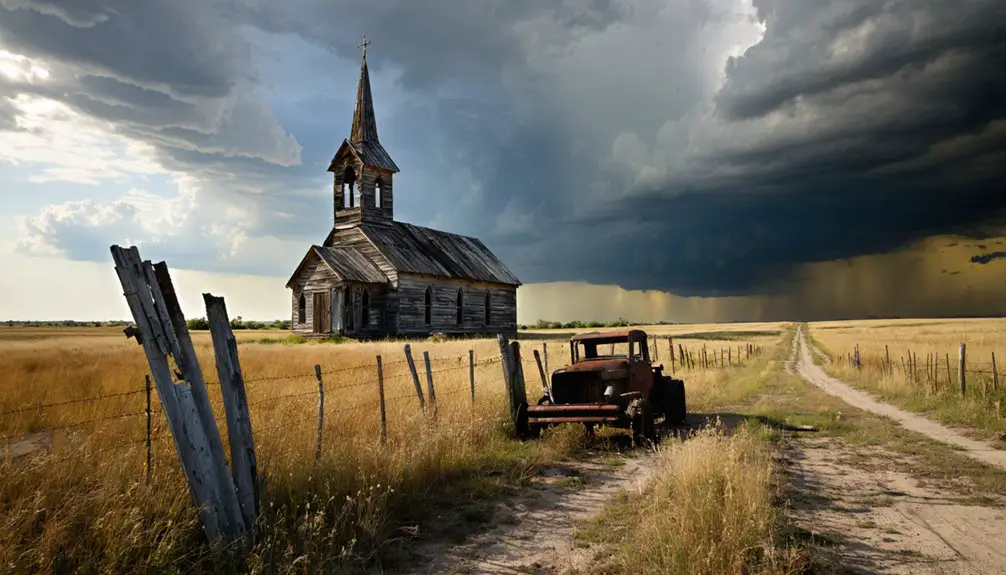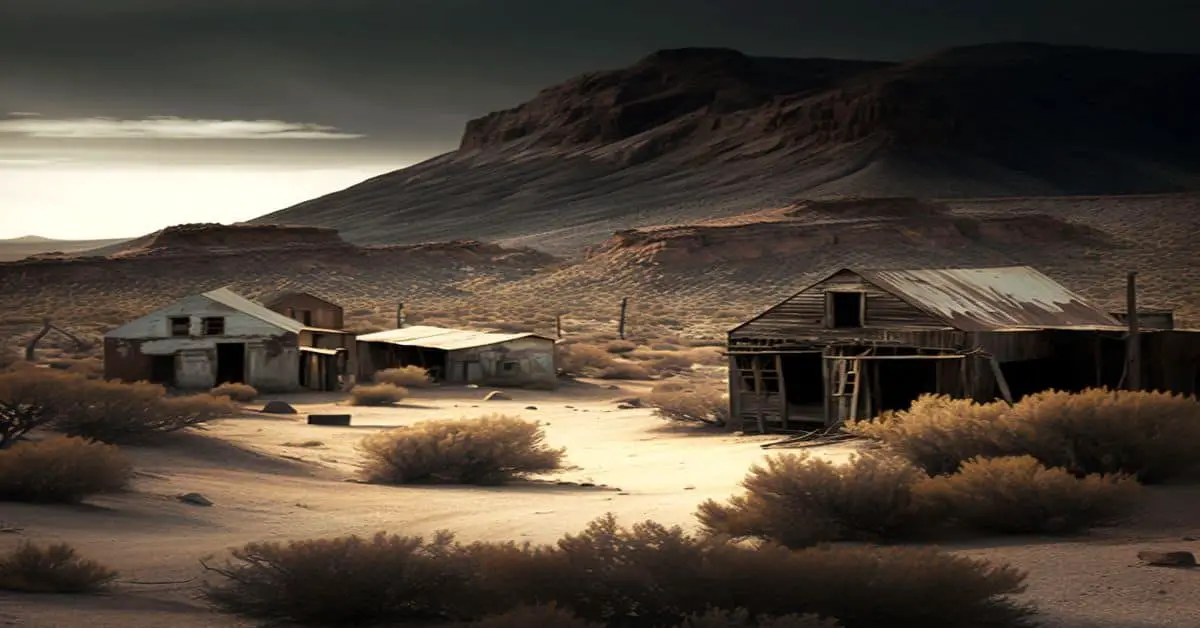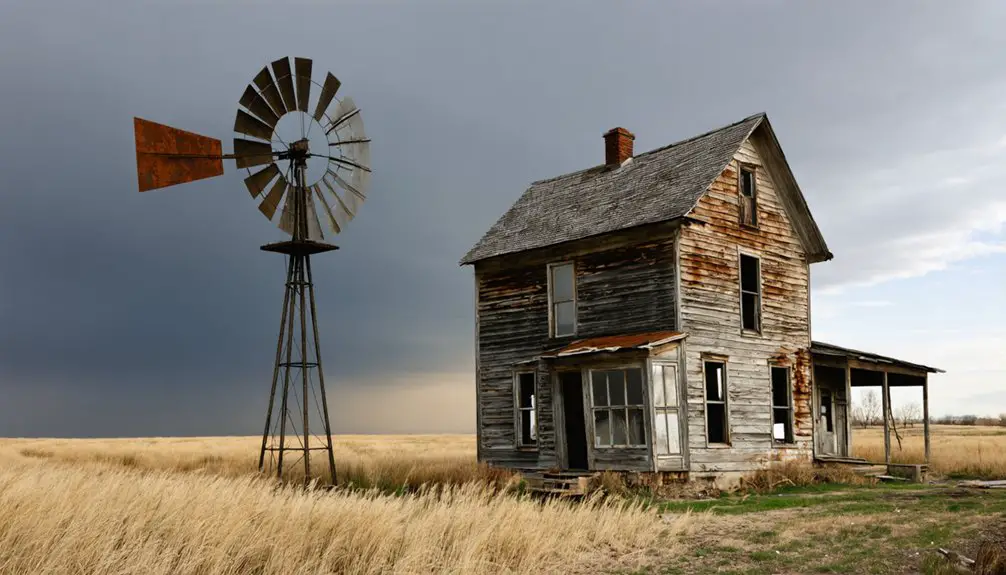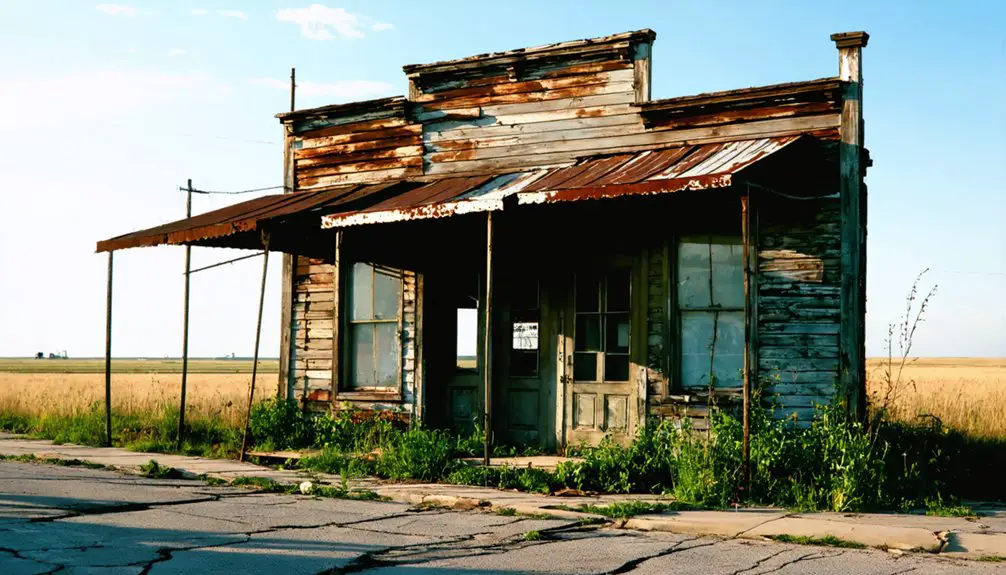You’ll find Pleasant Valley ghost town in southeastern Nebraska’s Saline County, nestled between Turkey Creek and Spring Creek. Christian Bobst and fellow pioneers established this settlement, which grew through land donations and the arrival of the Union Pacific railway in 1890. The community thrived with churches, stores, and farms until automobiles replaced rail transport. While limited physical evidence remains today, Pleasant Valley’s pioneer heritage lives on through local museums and heritage trails that reveal its fascinating past.
Key Takeaways
- Pleasant Valley was an early Nebraska pioneer settlement established near Turkey Creek and Spring Creek in Saline County during the 1800s.
- The town developed around the Union Pacific’s Omaha and Republican Valley Railway terminus in 1890, shaping its layout and economic growth.
- Daily life centered on agriculture, with residents maintaining gardens, tending livestock, and participating in community gatherings and church activities.
- The decline began with the rise of automobiles and decreased railroad usage, eventually leading to its abandonment and ghost town status.
- Today, only limited physical evidence remains of the settlement, though its history is preserved through local museums and heritage education programs.
Location and Geography in Saline County
Located in southeastern Nebraska’s Saline County, Pleasant Valley lies southwest of the city of Crete between Turkey Creek to the north and Spring Creek to the south.
Pleasant Valley rests between Turkey Creek and Spring Creek in southeastern Nebraska, a quiet spot southwest of Crete in Saline County.
You’ll find this ghost town at approximately 40.58667°N latitude and 97.08167°W longitude, nestled in a region of rolling plains and creek valleys.
The area’s geographic features showcase typical Midwestern prairie characteristics, though much of the original vegetative cover has given way to farmland over time.
The rich soil conditions have proven ideal for agricultural significance, supporting both crop farming and livestock operations. Like other Pleasant Hills communities across America, the area’s fertile landscape attracted early settlers.
The nearby Blue River Valley influences the local drainage patterns and ecosystem.
You’ll notice the gently sloping terrain that characterizes this part of Saline County, where the land naturally accommodates farming activities that have defined the region’s character.
After being platted in 1867, Pleasant Valley quickly became the most prosperous settlement in the county.
Pioneer Settlement Origins
You’ll find Pleasant Valley’s beginnings closely tied to Christian Bobst, who along with three other pioneers named the settlement after being struck by the South Fork river valley’s natural beauty.
Like many settlers, they chose to establish near streams for firewood while building their new community.
The settlement quickly established its civic foundations through Bobst’s appointment as Probate Judge, with Robert Turner serving as Constable and Joseph Fries as Justice of the Peace.
The Henry Pratt Family later strengthened the community’s infrastructure by donating land for the Pleasant Valley Cemetery, marking an important milestone in the settlement’s development.
Various religious groups including Methodist and Brethren churches helped establish strong spiritual foundations for the growing community.
Early Land Donations
As Pleasant Valley’s foundations took shape in the mid-1800s, William Remington’s pivotal land donation in 1865 established Swan City as one of Saline County’s earliest settlements. His generous land donation impacts rippled through the region, enabling the construction of essential pioneer infrastructure like stores and sawmills along Swan Creek’s strategic waterfront. Similar to Dr. Evans’ strategic river junction vision, the location proved advantageous for development. Like the town of Monowi’s sole resident, Pleasant Valley’s population gradually dwindled as settlers moved westward.
You’ll find that these pioneer settlement incentives attracted early residents by providing ready-made locations for community building. The donated lands quickly became hubs of activity, hosting everything from flour mills to winter performances by the O’Connor Circus.
When Saline County Commissioners met in Swan City in 1866, they formalized the town’s legal status through official platting on October 8th, transforming Remington’s gift into a structured township with defined boundaries and lots.
Railroad-Driven Town Planning
While William Remington’s land donation laid Pleasant Valley’s initial groundwork, the arrival of the Union Pacific’s Omaha and Republican Valley Railway in 1890 shaped the town’s permanent identity.
You’ll find that railroad logistics drove every aspect of community planning – from the strategic placement of the schoolhouse to the location of business districts near the tracks. The railway terminus on the north side of the South Loup River established key crossroads that would define the village’s layout. The town required careful disambiguation of locations to avoid confusion with other Pleasant Valleys across Nebraska.
Early settlers capitalized on freight stops like Peters’ Bridge, which supported the growing railroad network. The community faced challenges similar to other areas when grasshopper invasions devastated local crops between 1874-1878. When regular service began on March 1, 1890, you could witness rapid development as immigrants flocked to the area, drawn by the promise of cheap land and reliable shipping access for their crops.
Early Town Development
During the 1860s, Pleasant Valley emerged as a promising settlement in Saline County, Nebraska, thanks to strategic land donations from early settlers and investors. The town’s infrastructure quickly took shape as residents established essential services and governance structures to create a self-sufficient community.
The town’s early development focused on four critical elements:
- Building a mill to support local agriculture and commerce
- Establishing meeting halls for county commissioners and town governance
- Creating designated areas for businesses and residential plots
- Constructing public buildings to serve administrative functions
You’ll find Pleasant Valley’s initial growth mirrored other frontier towns of the era, as early leaders tackled governance challenges while working to attract settlers and investment.
The town’s brief stint as a county seat highlighted its early prominence in regional affairs.
Daily Life and Community
The church bells of Pleasant Valley would ring out each Sunday morning, drawing families from across town and surrounding farms to worship services and potluck gatherings.
You’d find residents participating in seasonal festivals, community picnics, and holiday celebrations that brought the small frontier community together in shared fellowship and mutual support.
In their homes, neighbors frequently gathered for quilting bees, barn raisings, and informal social visits where they’d share news, recipes, and help with daily chores.
Church and Social Events
As settlers established roots in Pleasant Valley, churches emerged as essential cornerstones of both spiritual and social life. You’d find these buildings serving multiple purposes, from Sunday services to community gatherings where neighbors strengthened their bonds through shared experiences.
Church gatherings and community events shaped the town’s vibrant social fabric through:
- Weekly religious services that brought scattered families together
- Seasonal celebrations including harvest festivals and holiday feasts
- Educational activities like Sunday school and youth Bible studies
- Charitable initiatives supporting families during tough times
If you’d visited Pleasant Valley in its prime, you’d have witnessed the church’s central role in maintaining community spirit.
Whether it was a barn raising, quilting bee, or potluck dinner, these social occasions kept the settlement’s heart beating strong until economic changes eventually led to its decline.
Neighborhood Home Activities
Life in Pleasant Valley revolved around daily activities that emphasized self-sufficiency and community cooperation. You’d find expansive gardens in yards and vacant lots, where families grew carrots, beans, and corn for their own consumption.
Garden maintenance wasn’t just a chore – it brought neighbors together, sharing tools and knowledge while children played freely among the vegetable rows.
Your daily routine might include tending to goats, preserving harvested food, and maintaining your wood-frame or brick home using materials from demolished buildings nearby. The town’s old windmill provided water for both household use and irrigation needs.
Community gatherings often centered around shared work projects, with neighbors helping each other repair homes or tend gardens.
You’d travel by horse-drawn wagon on dirt roads and paths, connecting with others through informal networks of produce exchange and social interactions that strengthened the tight-knit community bonds.
Economic Rise and Activities
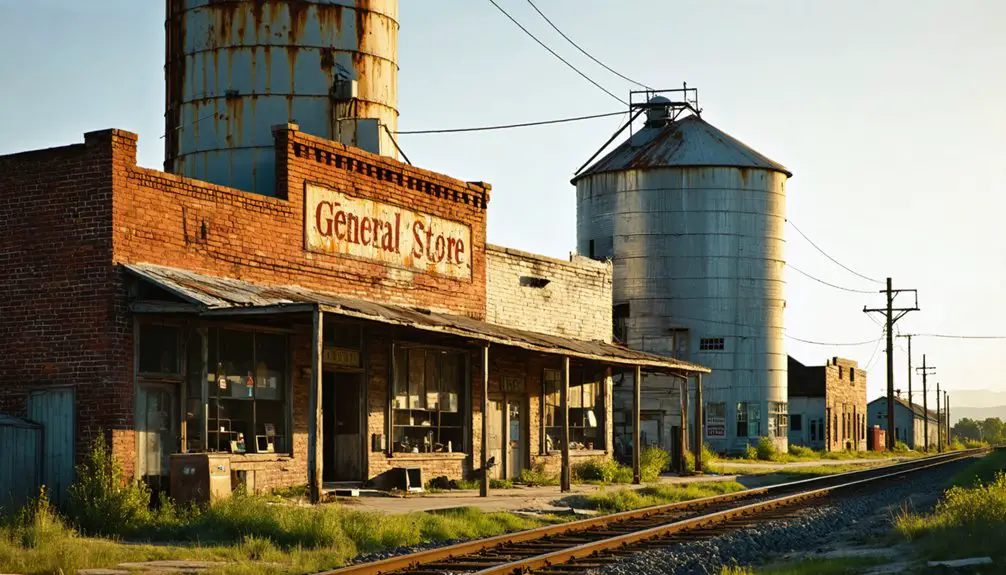
Pleasant Valley’s economic foundation rested firmly on agricultural pursuits, with farmers cultivating crops and raising livestock as primary revenue sources.
You’d find economic diversification through essential businesses that supported the farming community, though market resilience remained closely tied to seasonal harvests.
The town’s commercial heartbeat thrived through:
- Local mills processing grain for both community use and regional trade
- General stores and blacksmith shops serving residents and travelers alike
- Hotels hosting visitors while doubling as community gathering spaces
- Craftsmen maintaining crucial agricultural equipment and constructing buildings
If you’d visited during harvest season, you’d have witnessed the town’s bustling activity as farmers brought their crops to market, while merchants and tradesmen provided necessary services to keep the agricultural economy running smoothly.
Railroad Impact and Decline
When the railroads arrived in the late 1870s, they transformed Pleasant Valley’s economic landscape by establishing essential transportation links across Nebraska.
The railroad influence was particularly strong during the 1880s, as the Omaha & Republican Valley Railway expanded through the region, connecting farmers to distant markets and bringing new settlers to the area. Three separate branch lines were constructed north from Columbus to Norfolk, Albion, and Cedar Rapids between 1880 and 1886.
The Omaha & Republican Valley Railway transformed rural Nebraska, forging vital connections between frontier farmers and America’s expanding markets.
You’ll find that Pleasant Valley’s growth was closely tied to its rail depot, which served as a crucial hub for both passenger travel and agricultural shipments.
However, as automobiles and trucks gained popularity in the 20th century, service declines began to affect the town’s vitality.
The eventual absorption of local lines by Union Pacific led to reduced operations, and the abandonment of rail infrastructure marked a turning point in Pleasant Valley’s fortune, contributing to its eventual ghost town status.
Historical Legacy Today
Today’s visitors to Pleasant Valley will find more than just weathered remnants of a bygone era. The site’s cultural preservation efforts have transformed it into a living representation of Nebraska’s pioneer spirit, with historical markers and plaques telling stories of early settlers who shaped this land.
Ghost town tourism has breathed new life into Pleasant Valley’s legacy, making it a compelling stop for history enthusiasts.
You’ll discover why this place matters through:
- Local museums showcasing artifacts and photographs from the town’s heyday
- Heritage trails connecting you to other historic settlement sites
- Educational programs that bring pioneer life into focus
- Artistic works capturing the haunting beauty of these rural ruins
The town’s influence extends beyond its physical boundaries, inspiring documentaries, research papers, and cultural festivals that keep its memory alive.
Archaeological Findings and Remnants
Archaeological surveys of the area have yielded limited physical evidence of the once-thriving settlement. Like many Nebraska ghost towns, Pleasant Valley’s material culture has largely vanished, leaving behind scant traces of its former existence.
You’ll find that systematic excavations haven’t been conducted specifically at the site, making it challenging to piece together the town’s archaeological story.
While nearby ghost towns have revealed foundations, cellars, and scattered artifacts like household ceramics and metal tools, Pleasant Valley’s physical remnants remain largely undocumented.
Though regional discoveries hint at complex trade networks stretching back centuries, with items like stone heads and pottery fragments found in the broader Nebraska Sandhills area, archaeologists haven’t confirmed any direct connections to Pleasant Valley itself.
Frequently Asked Questions
Were There Any Notable Crimes or Lawlessness Incidents in Pleasant Valley?
Like a calm pond’s unrippled surface, you won’t find evidence of high crime rates or significant law enforcement challenges – historical records don’t show any notable incidents of lawlessness.
What Natural Disasters or Epidemics Affected Pleasant Valley During Its Existence?
You won’t find documented flooding events or disease outbreaks affecting this settlement. While the region faced typical Great Plains weather challenges and frontier health issues, no specific disasters were recorded here.
Did Any Famous Personalities or Historical Figures Visit Pleasant Valley?
You won’t find records of famous visitors or historical figures stopping by – the town’s limited historical significance and sparse documentation don’t reveal any notable personalities making documented appearances there.
What Native American Tribes Inhabited the Area Before Pleasant Valley’s Establishment?
You’ll find the Otoe Tribe and Pawnee Nation were primary inhabitants, alongside the Omaha, Ponca, and Missouria peoples, who farmed, hunted, and built earth lodges throughout this fertile river valley region.
Were There Any Unusual Legends or Folklore Associated With Pleasant Valley?
Picture whispers in the dark – you won’t find specific ghostly sightings tied to this place. While nearby areas like Seven Sisters Road have rich local myths, there aren’t documented legends unique to here.
References
- https://history.nebraska.gov/marker-monday-swan-city/
- https://history.nebraska.gov/wp-content/uploads/2017/12/doc_publications_NH1937GhostTowns.pdf
- https://www.youtube.com/watch?v=redtU6GT-BY
- https://dorchestertimes.blogspot.com/2019/12/pleasant-hill-one-of-nebraskas-most.html
- https://en.wikipedia.org/wiki/List_of_ghost_towns_in_Nebraska
- https://en.wikipedia.org/wiki/Pleasant_Hill
- https://www.tablerockhistoricalsociety.com/uploads/3/7/9/3/37937631/stories_of_early_settlers_along_the_nemaha_cheney.pdf
- https://history.nebraska.gov/wp-content/uploads/2017/12/doc_publications_NH1937PrizeStories.pdf
- https://usgennet.org/usa/ne/topic/resources/OLLibrary/pionrem/nepr0254.html
- https://history.nebraska.gov/wp-content/uploads/2017/12/doc_publications_NH1941Pioneers.pdf
